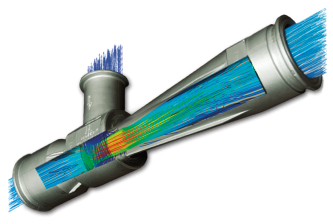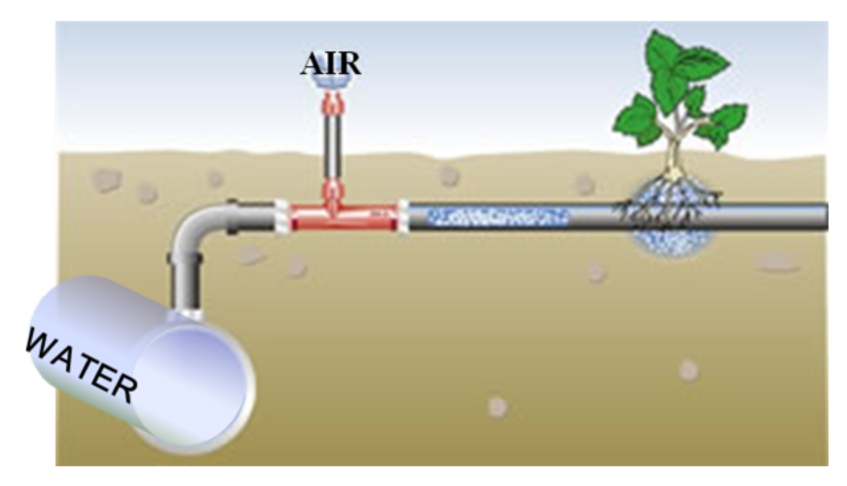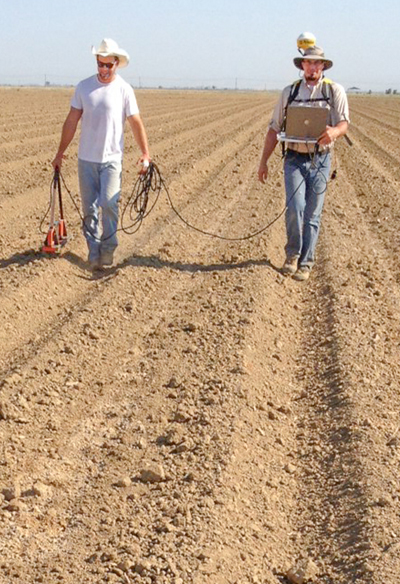California Agricultural Technology Institute
Adding oxygen to soil via subsurface drip
A team of Fresno State faculty and student researchers is seeking new applications of “AirJection® Irrigation” technology to help enhance crop yields on West Side San Joaquin Valley soils that would normally be too harsh for most vegetable crops.
AirJection is a term patented by the  Mazzei Injector Co. of Bakersfield and involves the injection of air into subsurface
drip irrigation systems as a means to help oxygenate soil. Fresno State Associate
Plant Science Professor Dave Goorahoo is leading the current work.
Mazzei Injector Co. of Bakersfield and involves the injection of air into subsurface
drip irrigation systems as a means to help oxygenate soil. Fresno State Associate
Plant Science Professor Dave Goorahoo is leading the current work.
“Injection of air into the root zone environment of plants has been shown to enhance crop productivity,” Goorahoo said in outlining several years of study he has led with the collaboration of Assistant Plant Science Professor Florence Cassel Sharma and a host of other Fresno State staff and student research specialists. “With the acceptance of subsurface drip irrigation (SDI) by commercial growers, implementation of an AirJection Irrigation system has become economically feasible.”
 The system itself is quite simple. It features the use of a high-efficiency venturi
injector to draw ambient air and mix it as microscopic bubbles into a subsurface irrigation
line. The amount of air drawn into the system can be adjusted by changing system pressure
or using different types of injectors.
The system itself is quite simple. It features the use of a high-efficiency venturi
injector to draw ambient air and mix it as microscopic bubbles into a subsurface irrigation
line. The amount of air drawn into the system can be adjusted by changing system pressure
or using different types of injectors.
The idea of somehow injecting air into a plant rootzone was initially offered more than 50 years ago by soil scientist W.D. Durell as a means of enhancing soil properties, Goorahoo noted. It has been shown to increase activity of soil microbes, enhance nitrogen availability, and reduce deep drainage of irrigation water.
The plants seem to like it too.
“In studies conducted through the Center for Irrigation Technology (CIT), we have observed increases as great as 33 percent in bell pepper count and a 39-percent increase in bell pepper weight for aerated plots versus the plots receiving only water,” Goorahoo said during a recent presentation at a Pacific Gas & Electric Co. sponsored workshop hosted by CIT. “On average, AirJection Irrigation has resulted in a 13- to 18-percent yield increase in fresh market tomatoes, cantaloupes, honeydews, broccoli, strawberries and sweet corn,” he added. Similar findings have been reported by researchers at Central Queensland University in Australia.
More recent work in organic farming systems has indicated that AirJection Irrigation also positively affected photosynthesis and soil respiration, stomatal conductance, leaf scale water use efficiency, plant-tissue nitrate concentrations, and shoot and root biomass, Goorahoo reported.
With actual commercial farming operations now starting to adopt AirJection, it was time to extend research efforts into harsher soils than the sandy loam used in past studies, he said.
“We believe that AirJection Irrigation will also show positive growth effects on other vegetables and fruits grown on heavy clay soils where salinity is a major hindrance to increased yields,” Goorahoo said.
In the current phase of study, Goorahoo and his team of faculty, staff and Fresno State student research assistants will evaluate AirJection on selected vegetable, row and tree crops commonly grown in the San Joaquin Valley. They will focus specifically on a tomato crop rotation over three years on a salt-affected heavy clay soil. In particular, Dr. Cassel Sharma will lead the efforts aimed at quantifying salinity changes in the field subjected to the AirJection Irrigation by using a non-destructive technique to map salinity levels.
 Team members will continue to monitor and record soil chemical properties including
salinity, growth rates of plants and root masses, and size and quality of yield.
Team members will continue to monitor and record soil chemical properties including
salinity, growth rates of plants and root masses, and size and quality of yield.
Photo at left shows Fresno State students Vincent Servin (left) and Michael DeWall conducting soil salinity measurements using the non-destructive electromagnetic induction sampling technique. All these results will be compared against control groups which receive “conventional” subsurface drip with no AirJection Irrigation.
In terms of future research, Goorahoo said “there is obviously now a need to go beyond the question of AirJection Irrigation impacts on crop yields and fruit quality. Hence, we have started collaborative research to evaluate the effects of AirJection on soil microbial populations and on the degree of oxidative stress in plants.” Researchers hope these combined studies will provide a better understanding of how to best implement the AirJection technology in ways that make crop production systems economically feasible, environmentally sound and “socially acceptable.”
Additional results on this work will be presented at various conferences and workshops, and through other media channels, Goorahoo said. For more information, contact him at dgooraho@csufresno.edu.
Partial funding for this project was provided by the California State University Agricultural Research Institute (ARI).